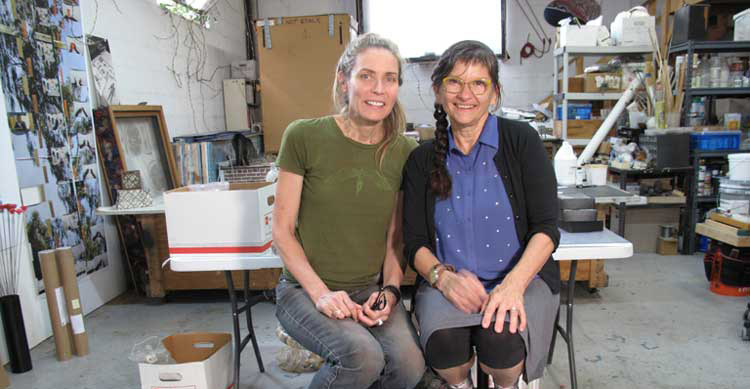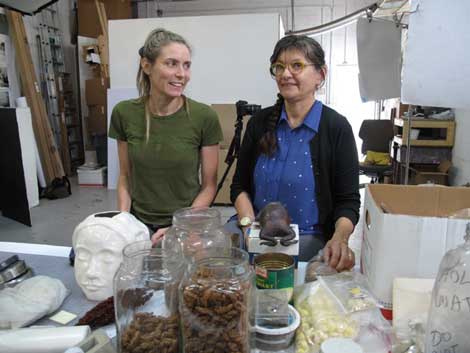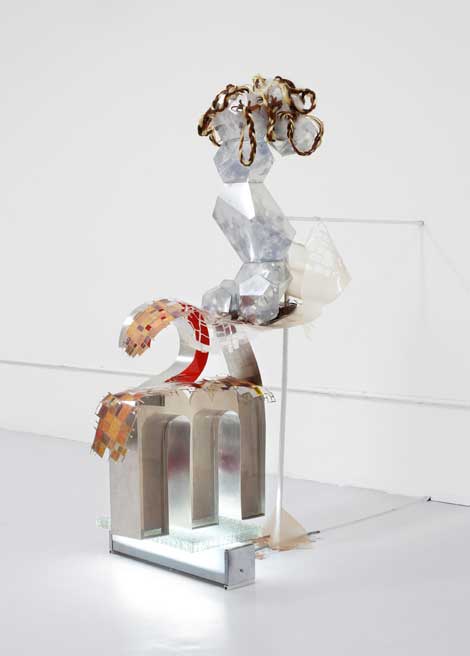Many young artists, especially those coming right out of school, find working as a studio assistant to be a valuable intermediary step. If they are lucky, they learn practical skills—and perhaps even more importantly—they make significant connections with more accomplished artists.
Rebecca Ripple completed her MFA at Yale in 1995 and decided to move to Los Angeles. She identified five women sculptors in the region and wrote them, asking if they needed a studio assistant. Kim Abeles was the first artist to respond.

Kim Abeles, Walk a mile in my shoes, 2014, Bronze replica of Martin Luther King Jr.’s shoes; Photographic tiles of shoes belonging to Civil Rights marchers; handmade concrete pavers and insets including biographies of the marchers. The second site features shoes of local activists. Photo by Ken Marchionno.
Abeles hired her first studio assistant in the early 1980s: a student from UC Irvine who worked for college credit. The student “shadowed” Abeles in the studio, with the artist acting as a mentor. Since then, Abeles has had more than 20 various assistants. (Wistfully, she recalls hearing that George Rickey had two assistants who stayed with him throughout his career.) A longtime professor, Abeles is convinced that the kind of learning that happens in the studio, especially the sculpture studio, cannot be duplicated in the traditional classroom. “There are thousands of things to know and all of them involve problem-solving. You can’t just say to an assistant, ‘Here, fix this.’ You have to teach them how to fix it. You have to give them each step in the process. Because sculpture exists in the physical world, and because it always involves a certain aesthetic, the ‘fix’ can come down to which screw is being used, and how it’s being used.” Abeles continues, “Sometimes, I don’t know what to do with people in my studio. I want to do everything, make every cut, every paint splatter myself. If I didn’t have to hire anyone, it would be better. But they’re not just helping me. They’re learning things.”
Abeles has seen “the gamut” of how people respond in studio assistant situations. She is aware of the vulnerability required in certain parts of the art process. “It’s sometimes hard for the artist to relinquish control. And certain assistants, because they’re artists themselves, form emotional attachments to the art and want to take ownership. The dynamics between the artist in charge and the assistant can become conflictual.” Luckily, such conflict did not develop between Abeles and Ripple.
“Rebecca worked for me when I was living in the Santa Fe Art Colony. I had her do a lot of paperwork—mailing lists, etc.—which probably seemed like busy work to her. But it was work that had to get done.” And Ripple came out of the experience admiring Abeles’ “high level of organization.” The bureaucratic record keeping aspect of studio life was “novel” to the young sculptor, something she had never imagined she would need as an artist.
While they worked together, Abeles and Ripple enjoyed deep, long conversations about their work. Part of their professional connection came from shared aesthetic concerns. Both deal with issues of identity—especially female identity—and how they intersect with politics, urban life and the environment. Abeles has always been a content-based sculptor, working with topics as diverse as Christian saints and presidential policies on smog and other pollutants. Her most recent body of work, “Walk a Mile in My Shoes,” is a public art project honoring those who marched for Civil Rights. Reverend Dr. Martin Luther King and many of his friends and colleagues are memorialized in reproductions of their shoes set into large tiles. Installed in a mile-long stretch of Rodeo Road between Jefferson and MLK Boulevard in Southwest Los Angeles near Culver City, the parade of shoes symbolizes the physical labor of community and social change.
When Ripple arrived in Southern California, she was doing work related to the body, to the self in space. She realized her self-perception began to change as she adjusted to the new city: “It was as if I were measuring my body, dealing with it in these new spaces, and seeing old ideas about the body as distorted. Today, my work responds to the conflicting cultural forces that affect me, from Catholicism to consumerism, women’s health to urban signage. It’s still portraiture in a certain sense, still about my trajectory in the world.” One of Ripple’s recent pieces—Scorpion from 2012—embodies the contradictions the artist often explores. A braided pair of elements emerges from a tilted linoleum floor. It shuttles between domestic comfort (a culinary utensil?) and physical threat (an overlarge speculum, the maws of an immense predator?), compelling us to jettison comfortable conceptual categories in favor of careful reconsideration.
Abeles was remarkably generous in introducing the young artist to art world notables and in talking to her about negotiating the Los Angeles scene. In turn, being a studio assistant served Ripple as a good way to orient herself in Southern California, affording her professional connections she didn’t have since she didn’t attend art school here. “I loved the fact that I could get a glimpse into someone else’s process. And I had relationships with people I wouldn’t otherwise have had access to. But it could be exhausting to work all day for someone else and then turn around and do my own work. I’ve had assistants myself now and I realize it’s tough to be in that position, to be clear about what you want from them. Being an assistant made me value my own assistants even more.”
Look for Rebecca Ripple’s upcoming solo exhibition at Klowden/ Mann Gallery in 2015
Ripple will also show at LAMOA’s project space in a group show December 2014.
See Kim Abeles’ Cabinet of Wondering, a new video-media wall installation at Technology & the Natural World, curated by Kerry Oliver-Smith, Curator of Contemporary Art for the Harn Museum at the University of Florida through July 26, 2015 ; “Following the Prescribed Path,” Laband Gallery, Loyola Marymount University with Kim Abeles, Vito Acconci, Bas Jan Ader, Gabrielle Ferrer, Erin Mallea, Diane Meyer, and Mark Ruwedel. September 13 – November 23, 2014




